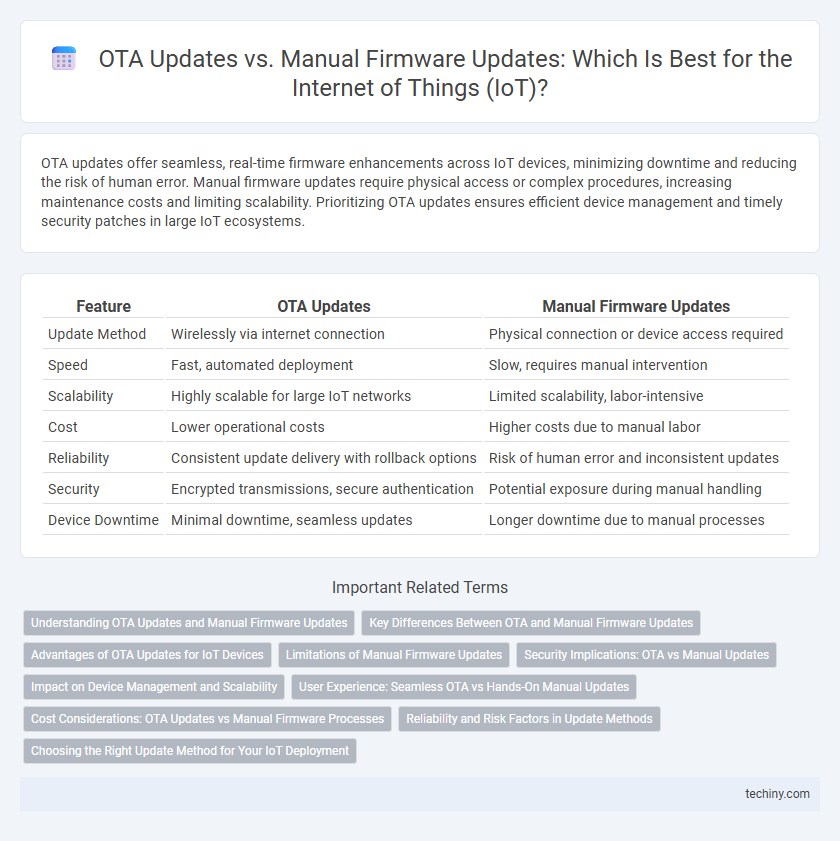OTA updates offer seamless, real-time firmware enhancements across IoT devices, minimizing downtime and reducing the risk of human error. Manual firmware updates require physical access or complex procedures, increasing maintenance costs and limiting scalability. Prioritizing OTA updates ensures efficient device management and timely security patches in large IoT ecosystems.
Table of Comparison
| Feature | OTA Updates | Manual Firmware Updates |
|---|---|---|
| Update Method | Wirelessly via internet connection | Physical connection or device access required |
| Speed | Fast, automated deployment | Slow, requires manual intervention |
| Scalability | Highly scalable for large IoT networks | Limited scalability, labor-intensive |
| Cost | Lower operational costs | Higher costs due to manual labor |
| Reliability | Consistent update delivery with rollback options | Risk of human error and inconsistent updates |
| Security | Encrypted transmissions, secure authentication | Potential exposure during manual handling |
| Device Downtime | Minimal downtime, seamless updates | Longer downtime due to manual processes |
Understanding OTA Updates and Manual Firmware Updates
OTA updates enable seamless remote firmware installations over-the-air, significantly reducing downtime and eliminating the need for physical device access. Manual firmware updates require direct interaction, often involving USB or serial connections, resulting in longer update cycles and increased labor costs. Understanding the efficiency, security implications, and scalability of OTA updates versus manual methods is crucial for managing IoT device fleets effectively.
Key Differences Between OTA and Manual Firmware Updates
OTA updates enable remote, wireless firmware upgrades, significantly reducing downtime and minimizing the need for physical access to IoT devices. Manual firmware updates require direct connection or on-site intervention, increasing labor costs and the risk of human error during installation. OTA updates facilitate scalable, real-time deployment across large IoT networks, whereas manual methods struggle with efficiency and consistency in distributed environments.
Advantages of OTA Updates for IoT Devices
OTA updates for IoT devices enable seamless and remote firmware upgrades, significantly reducing downtime and maintenance costs. They enhance security by allowing timely deployment of patches and vulnerability fixes across widespread device networks. This method improves scalability, facilitating efficient management of thousands of IoT endpoints without physical intervention.
Limitations of Manual Firmware Updates
Manual firmware updates in Internet of Things (IoT) devices face significant limitations such as time-consuming deployment across large-scale networks and increased risk of human error during the update process. These updates often require physical access to devices, causing logistical challenges and higher maintenance costs. Manual processes also delay critical security patches, potentially exposing IoT systems to vulnerabilities and operational failures.
Security Implications: OTA vs Manual Updates
Over-the-air (OTA) updates provide enhanced security by enabling timely patches and reducing the window of vulnerability compared to manual firmware updates, which rely on slower, human-dependent processes and may result in delayed responses to critical threats. OTA updates support encrypted transmission and authentication protocols, minimizing risks of firmware tampering and unauthorized access during deployment. Manual updates often increase exposure to physical tampering and human error, leading to potential inconsistencies in security posture across IoT devices.
Impact on Device Management and Scalability
OTA updates streamline device management by enabling remote, automated firmware installations, reducing the need for physical interventions and minimizing device downtime. This approach enhances scalability as it allows simultaneous updates for large IoT fleets regardless of geographic distribution. In contrast, manual firmware updates require significant labor and logistical coordination, limiting scalability and increasing the risk of inconsistent device performance across the network.
User Experience: Seamless OTA vs Hands-On Manual Updates
Over-the-air (OTA) updates enable seamless firmware enhancements without disrupting device functionality, significantly improving user experience by eliminating manual intervention. In contrast, manual firmware updates require hands-on actions such as downloading, transferring files, and device restarts, which increase the risk of errors and device downtime. OTA updates ensure continuous device optimization and security with minimal user effort, making them the preferred choice for Internet of Things ecosystems.
Cost Considerations: OTA Updates vs Manual Firmware Processes
OTA updates significantly reduce costs by eliminating the need for physical access to devices and minimizing labor expenses associated with manual firmware updates. Manual firmware processes incur higher operational costs due to on-site maintenance, device transportation, and increased downtime. Investing in OTA updates enhances scalability while optimizing resource allocation in IoT device management.
Reliability and Risk Factors in Update Methods
OTA updates in the Internet of Things offer higher reliability by enabling seamless, automated firmware improvements without physical intervention, reducing downtime and human error. Manual firmware updates carry increased risk due to potential installation mistakes, device accessibility issues, and inconsistent update application across distributed devices. OTA methods also mitigate security vulnerabilities by delivering timely patches, whereas manual updates often suffer delays that can expose devices to prolonged threats.
Choosing the Right Update Method for Your IoT Deployment
Choosing the right update method for your IoT deployment depends on device scale, connectivity, and security requirements. OTA updates enable seamless, remote firmware upgrades across large fleets, reducing downtime and operational costs. Manual firmware updates may be suitable for isolated or low-criticality devices where control over each update is essential.
OTA updates vs Manual firmware updates Infographic

 techiny.com
techiny.com